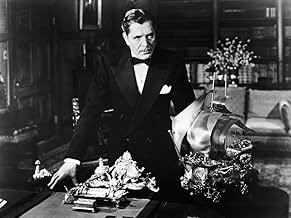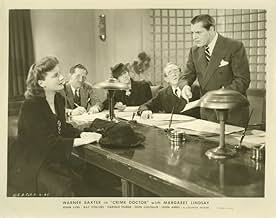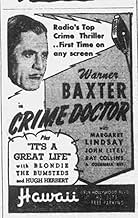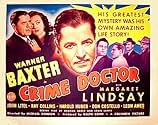Amnesia victim, Robert Ordway, becomes the country's leading criminal psychologist. After he is hit on the head by someone from his past, he suddenly remembers his previous life as a crimina... Read allAmnesia victim, Robert Ordway, becomes the country's leading criminal psychologist. After he is hit on the head by someone from his past, he suddenly remembers his previous life as a criminal.Amnesia victim, Robert Ordway, becomes the country's leading criminal psychologist. After he is hit on the head by someone from his past, he suddenly remembers his previous life as a criminal.
Phil Arnold
- Third Reporter in Court
- (uncredited)
Paul Bryar
- First Reporter in Court
- (uncredited)
Wallis Clark
- Judge
- (uncredited)
Chester Clute
- Headwaiter
- (uncredited)
Kernan Cripps
- Turnkey
- (uncredited)
Harold De Becker
- Bartender
- (uncredited)
Franklyn Farnum
- Juror
- (uncredited)
Featured reviews
With the exception of the Rathbone and Bruce Sherlock Holmes series, this is quite possibly the best of the 'mystery' series of the 30s and 40s. The series begins with this movie as Phil Morgan, master criminal, is double crossed by his gang, beaten and dumped along a roadside. As a result, he suffers from amnesia. This movie, the first of the series, establishes The Crime Doctor's background, explains how and why he became a doctor (a psychiatrist, actually), head of the parole board and helped many convicts find the 'straight and narrow'.
The element that makes this movie and the series in general unique is that it relies on psychiatry and the tendencies of the mentally ill. They often tease you by inserting an obviously unbalanced person and although the plot may lead one to believe that person is the "perp" they may or may not be the actual "perp". Because psychiatry was relatively new and often misunderstood, it provided general insight to the subject. In many ways, the series has yet to become dated although the psychological concepts may appear to be fairly basic nowadays.
A series of factors make this movie series much more enjoyable than others such as The Lone Wolf, Boston Blackie or Bulldog Drummond. The first is the consistency. The quality of the stories in all ten movies remains high throughout the series where the stories of other series tend to deteriorate into standard potboilers after the studio has captured the audience's interest. Second, the same actor plays the lead character in all of the movies. Third, the quality of the supporting cast is exceptional throughout the series. Some of the more recognizable supporting cast includes John Litel, Ray Collins, Harold Huber, Barton MacLane, Jerome Cowan, Reginald Denny, Eduardo Ciannelli, Nina Foch, George Zucco, Ben Weldon, Hillary Brooke, William Frawley, Ellen Drew and last, but far from least, a very young Lois Maxwell who played Miss Moneypenny in at least 15 James Bond films.
However, over the six years the series was shot, one can easily see Baxter's health deteriorating.
The element that makes this movie and the series in general unique is that it relies on psychiatry and the tendencies of the mentally ill. They often tease you by inserting an obviously unbalanced person and although the plot may lead one to believe that person is the "perp" they may or may not be the actual "perp". Because psychiatry was relatively new and often misunderstood, it provided general insight to the subject. In many ways, the series has yet to become dated although the psychological concepts may appear to be fairly basic nowadays.
A series of factors make this movie series much more enjoyable than others such as The Lone Wolf, Boston Blackie or Bulldog Drummond. The first is the consistency. The quality of the stories in all ten movies remains high throughout the series where the stories of other series tend to deteriorate into standard potboilers after the studio has captured the audience's interest. Second, the same actor plays the lead character in all of the movies. Third, the quality of the supporting cast is exceptional throughout the series. Some of the more recognizable supporting cast includes John Litel, Ray Collins, Harold Huber, Barton MacLane, Jerome Cowan, Reginald Denny, Eduardo Ciannelli, Nina Foch, George Zucco, Ben Weldon, Hillary Brooke, William Frawley, Ellen Drew and last, but far from least, a very young Lois Maxwell who played Miss Moneypenny in at least 15 James Bond films.
However, over the six years the series was shot, one can easily see Baxter's health deteriorating.
I hope that TCM broadcasts more of the "Crime Doctor" series, based on the radio show. Starring Warner Baxter, 1943's "Crime Doctor" is one of the first films Michael Gordon (Pillow Talk) directed, and it's a good, solid B movie.
Baxter plays a criminal named Phil Morgan who gets amnesia after being left for dead on the side of a road. He rehabilitates himself and, still not knowing who he is, becomes a noted psychiatrist named Robert Ordway who works with prisoners as well as other patients.
However, Phil Morgan stole and hid $200,000 and his fellow gang members want the money. As word gets around that Dr. Ordway is Phil Morgan, the question is - does he really not remember, or does he know who he is and where he put the money?
Baxter was 54 years old when this film was made. Fifty-four in 1943 isn't what it is today, so when the character announces that "thirty years of his life" have been wiped out, one wonders which thirty years he's talking about.
The film covers a span of ten years, but it's just as hard to buy he's forty. It's a minor point - Baxter gives a sincere performance with an undertone of real gentleness.
The supporting cast includes the lovely Margaret Lindsay, John Litel (who play Nancy Drew's father in the series), Perry Mason's Ray Collins, and Leon Ames.
Baxter plays a criminal named Phil Morgan who gets amnesia after being left for dead on the side of a road. He rehabilitates himself and, still not knowing who he is, becomes a noted psychiatrist named Robert Ordway who works with prisoners as well as other patients.
However, Phil Morgan stole and hid $200,000 and his fellow gang members want the money. As word gets around that Dr. Ordway is Phil Morgan, the question is - does he really not remember, or does he know who he is and where he put the money?
Baxter was 54 years old when this film was made. Fifty-four in 1943 isn't what it is today, so when the character announces that "thirty years of his life" have been wiped out, one wonders which thirty years he's talking about.
The film covers a span of ten years, but it's just as hard to buy he's forty. It's a minor point - Baxter gives a sincere performance with an undertone of real gentleness.
The supporting cast includes the lovely Margaret Lindsay, John Litel (who play Nancy Drew's father in the series), Perry Mason's Ray Collins, and Leon Ames.
Crime Doctor (1943)
** (out of 4)
First film in Columbia's Crime Doctor series has a man (Warner Baxter) thrown out of a car, which leaves him with amnesia. Not knowing who he is, the man decides to start a new life as a doctor but then learns that in his previous life he was a gangster. This was the first film from the series that I watched and I certainly hope they get better. I suspect this film just tells a backstory, which could have been told in the first five minutes of another movie. I found the film incredibly dull and the story itself really wasn't all that involving. Baxter was good in his role but I still wouldn't rank him very high among the countless mystery/detective films of the 30's and 40's.
** (out of 4)
First film in Columbia's Crime Doctor series has a man (Warner Baxter) thrown out of a car, which leaves him with amnesia. Not knowing who he is, the man decides to start a new life as a doctor but then learns that in his previous life he was a gangster. This was the first film from the series that I watched and I certainly hope they get better. I suspect this film just tells a backstory, which could have been told in the first five minutes of another movie. I found the film incredibly dull and the story itself really wasn't all that involving. Baxter was good in his role but I still wouldn't rank him very high among the countless mystery/detective films of the 30's and 40's.
When a man is thrown from a speeding car, he awakens without a clue who he is. It takes ten years for him to rehabilitate into the renowned "Dr. Ordway" (Warner Baxter), a man who ends up esteemed enough to be put in charge of the parole board. It's as he is making a broadcast that an inmate elsewhere (Dorothy Tree) recognises his voice and identifies criminal mastermind "Philip Morgan" - a man whose gang stole $200,000 that is still unaccounted for. It's not just her who has identified him, and pretty swiftly his erstwhile gang are also on his trail wanting their loot. "Ordway" realises that he still has some cards to play in his dealings with their leader "Caspair" (John Litel) that might just help him fully re-establish his identity and hopefully find the money. This is quite an engaging little mystery that allows Baxter to establish his character's credentials as a competent detective whilst using some elementary psychology, the odd shrug and a wry smile to provide us with a decently paced cat-and-mouse drama that presents our protagonist with a sort of lose-lose scenario towards the end. The production is adequate, the dialogue quite entertaining and it amiably sets the scene for more to come.
In the 1930s and 40s, Hollywood made a huge number of "B" detective series films. They were called "B" because they had lower budgets, were shorter than the average film and were meant to be the second film in a double feature--the lesser of the two films. In general, these films were a lot of fun to watch BUT they also were very formulaic and repetitive. I enjoy Sherlock Holmes, Charlie Chan, Boston Blackie and the Saint, but will gladly admit that once you've seen a few they all seem to blend together--particularly the Blackie series. It is because of this sameness that I really, really appreciate the Crime Doctor films--they are not so predictable and offer some nice innovations.
This movie is the first, and from what I've seen, the best of the Crime Doctor films. It sets the stage for future films by explaining how Warner Baxter became a psychiatrist and crime solver and is well-written and interesting throughout--even though this movie's plot isn't original--having been a variation on a film from 1936. The acting is very good and the film is played more seriously than the average film of the genre--with no goofy sidekick or stupid police investigator. And, frankly, this is a good thing as the others are clichés that just seem to permeate almost every B detective film. Give it a watch--it's very enjoyable and doesn't disappoint, as the characters behave intelligently and believably.
This movie is the first, and from what I've seen, the best of the Crime Doctor films. It sets the stage for future films by explaining how Warner Baxter became a psychiatrist and crime solver and is well-written and interesting throughout--even though this movie's plot isn't original--having been a variation on a film from 1936. The acting is very good and the film is played more seriously than the average film of the genre--with no goofy sidekick or stupid police investigator. And, frankly, this is a good thing as the others are clichés that just seem to permeate almost every B detective film. Give it a watch--it's very enjoyable and doesn't disappoint, as the characters behave intelligently and believably.
Did you know
- TriviaRay Collins, who plays Dr. Carey in this film, is one of several actors who played the title character in the "Crime Doctor" radio series.
- ConnectionsFollowed by Crime Doctor's Strangest Case (1943)
Details
- Release date
- Country of origin
- Language
- Also known as
- Karanlık mazi
- Filming locations
- Mulholland Drive, Hollywood Hills, Los Angeles, California, USA(Establishing shot.)
- Production company
- See more company credits at IMDbPro
- Runtime1 hour 6 minutes
- Color
- Aspect ratio
- 1.37 : 1
Contribute to this page
Suggest an edit or add missing content



































